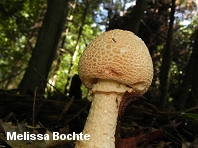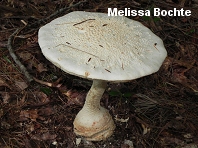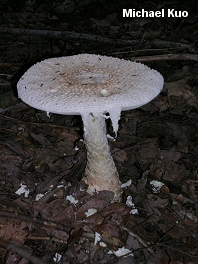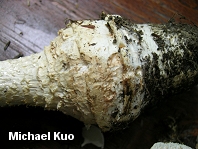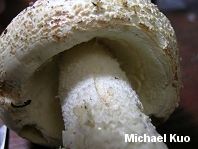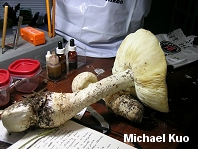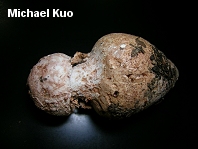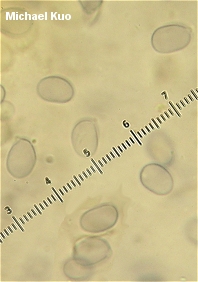| Major Groups > Gilled Mushrooms > Pale-Spored > Amanita > Amanita daucipes |

|
Amanita daucipes [ Basidiomycetes > Agaricales > Amanitaceae > Amanita . . . ] by Michael Kuo Here is an impressive species of Amanita, characterized by its very large size and its orangish to pinkish brown universal veil, which leaves small scales on the cap surface and covers the large basal bulb with loosely arranged fragments and ringlets. As the mushrooms mature they become more whitish, and less pink or orange; in this stage, veil material typically hangs from the edges of the cap and discarded fragments surround the mushroom on the ground. The odor of Amanita daucipes is strong and peculiar: a mixture of sweetness and foulness, with a hint of rotting meat and chlorine. While the range of Amanita daucipes extends from New Jersey to Texas and Mexico, it is most common in the Appalachian Mountains. Description: Ecology: Mycorrhizal with oaks, but often found in mixed woods where oaks and conifers are both present; usually growing alone or scattered, but sometimes growing gregariously; summer and fall; probably widely distributed in eastern North America below the Great Lakes, but more common in the Appalachians. Cap: 6-25 cm; convex or nearly round at first, expanding to planoconvex or flat; dry; when young covered with orangish to pinkish brown universal veil material that breaks up as the mushroom matures, forming a dense covering of soft, orangish to pinkish brown or nearly whitish warts above a whitish ground color; the margin not lined, but often hung with large chunks and patches of veil material. Gills: Free from the stem or slightly attached to it; close or nearly crowded; white to faintly yellowish; with frequent short-gills. Stem: 8-20 cm long above ground; 2.5-4 cm thick in the midportion; more or less equal above a club-shaped bulb that is up to 8 cm wide and often extends a "root" far into the ground (up to 10 cm or more); whitish; covered with soft, cottony veil material; with a delicate ring (often missing); with orangish to pinkish brown, soft scales and floccules of universal veil material covering the bulb. Flesh: White; not staining on exposure. Odor: Strong, sweet, and a little foul; somewhat reminiscent of chlorine and, when old, of rotting meat. Chemical Reactions: KOH negative on cap surface. Spore Print: White. Microscopic Features: Spores 7-12 x 5-7 µ; ellipsoid; smooth; amyloid. Basidia 4-spored; basally clamped. Pileipellis an ixocutis or cutis of elements 2-6 µ wide. Lamellar trama bilateral; subhymenium ramose, or with slightly inflated cells. REFERENCES: (Berkeley & Montagne, 1856) Lloyd, 1898. (Saccardo, 1887; Bas, 1969; Jenkins, 1986; Phillips, 1991/2005; Metzler & Metzler, 1992; Roody, 2003; Miller & Miller, 2006; Binion et al., 2008; Tulloss, 2013.) Herb. Kuo 07291207. This site contains no information about the edibility or toxicity of mushrooms. |
© MushroomExpert.Com |
|
Cite this page as: Kuo, M. (2013, May). Amanita daucipes. Retrieved from the MushroomExpert.Com Web site: http://www.mushroomexpert.com/amanita_daucipes.html |
